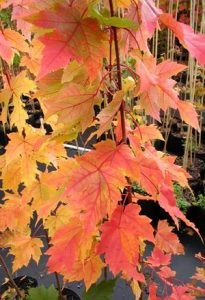 As autumn returns to the high country, trees and shrubs show off one last time before they hibernate in preparation for spring of 2014. Today’s column highlights the new, the improved, and the unusual fall colors that can be brought into our gardens.
As autumn returns to the high country, trees and shrubs show off one last time before they hibernate in preparation for spring of 2014. Today’s column highlights the new, the improved, and the unusual fall colors that can be brought into our gardens.
Armstrong Maple sports the brightest orange leaves of all shade trees. It is similar in size to its cousin the blaze maple so give it “room to grow”. Mature growth is 40 feet tall by 20 feet wide. It bursts into autumn with rare colors that complement the red of blaze maples, purple of raywood ash, and aspen golds.
Red Rhapsody Maple is a short maple, known for red foliage that seems to ignite a landscape. It is well adapted to mountain clay soils, sun, wind, and cold winters. Once rooted in a landscape it is easy on irrigation, and perfect for fire-wise landscape needs. Though sometimes mistaken for a Japanese Maple this mountain variety is the far hardier of the two trees. Whether grown as a short multi-trunk tree or a tall shrub, it is on my list of preferred ‘water-wise’ plants.
Ornamental Pistachio trees are for gardens exposed to wind and subjected to micro-bursts or other weather anomalies. This real autumn show-off thrives in harsh environments and with neglect. The attractive umbrella shape turns a brilliant crimson; no other tree produces such a vibrant, broad range of fall color. It can serve dozens of uses: as a shade tree, street tree, accent, or front yard specimen. It is the ideal choice for flanking driveways or in pairs to meet overhead at street side. Grow this colorful water-wise tree against a solid evergreen background to provide intense contrast in any landscape.
 Lace Leaf Staghorn Sumac is one of the drought hardy plants that can be grown as either a shrub or a small tree. Its fall foliage, auburn orange through red, is striking, and the more sun this plant receives the brighter its colors. When mountain winds have blown away the last of its leaves, the plant is left with a very unusual characteristic: It appears to be covered in a fur that is very soft to the touch.
Lace Leaf Staghorn Sumac is one of the drought hardy plants that can be grown as either a shrub or a small tree. Its fall foliage, auburn orange through red, is striking, and the more sun this plant receives the brighter its colors. When mountain winds have blown away the last of its leaves, the plant is left with a very unusual characteristic: It appears to be covered in a fur that is very soft to the touch.
Red Wall Virginia Creeper is a creeper variety new this fall. Good to grow over rocks, up fences, and as a ground cover, this vine likes full sun locations. In fact, whether showing its summer green or fire engine red fall foliage, its color is brightest when exposed to intense sun. It’s one of the ‘best selections’ on both my fire-wise and water-wise plant lists.
~~ ~~ ~~ ~~ ~~ ~~ ~~
Feed for best color – Bring the most color out of your landscape’s autumn foliage by feeding with an all- natural plant food. Natural plant foods release slowly for plants to assimilate and are far safer than synthetic foods around children and pets. Simply sprinkled on top of soil and/or rock this type of food will work its way into garden soil and to hungry roots. My “All Purpose Plant Food” 7-4-4 should be applied by the end of the month, but do it right away to bring the most color out of fall-colored plants.
When to plant – You folks from the Midwest already know the importance of the fall planting season. Gardeners from other parts of the country should adopt this knowledge and not be afraid to plant now. This week’s cool down should increase planting success rates even more.
Try to get new plants with fall-colored foliage into the ground before they turn color so their colors can be enjoyed this year. Even better, since nursery trees can live in their growers’ pots for months before planting, use them as fall decorating elements with some pumpkins, a few mums, and a pansy or two. When all the leaves have dropped, plant them in their permanent spots in the landscape.
~~ ~~ ~~ ~~ ~~ ~~ ~~
Garden Alert – The aphids have landed! The aphids have landed! This tiny little green bug and its larger cousin, the black tree aphid, love this cool weather. Do not let their small statures deceive you, they are destructive, and, boy, can they kill! Telltale symptoms of their destructive presence are curled leaves, yellowing of evergreens, and a glossy, almost wet, look under plants. Aphids on trees next to a driveway can leave spotting on cars planted under those trees. Fortunately, instant extinction can be dealt on these pests with a generous dose of my “Multi Purpose Insect Spray”. Spray infected plants until their foliage is sopping wet, actually dripping to the ground. Aphids like it cool and often hide at the base of plants so make sure to spray the base of each plant. Get a good hose end sprayer and spray, spray, spray.
Until next week, I’ll see you in the garden center.

